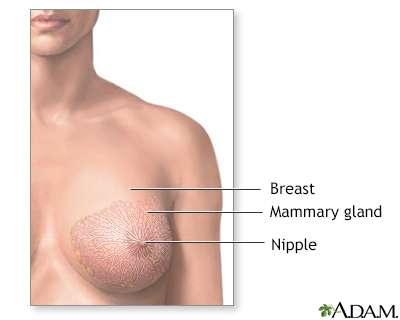Pregnancy SmartSiteTM
Discharge from breasts; Milk secretions; Lactation - abnormal; Witch's milk (neonatal milk); Galactorrhea; Inverted nipple; Nipple problems; Breast cancer - discharge DefinitionNipple discharge is any fluid that comes out of the nipple area in your breast. CausesSometimes discharge from your nipples is OK and will get better on its own. You are more likely to have nipple discharge if you have been pregnant at least once. Nipple discharge is most often not due to cancer (thus a benign condition), but rarely, it can be a sign of breast cancer. It is important to find out what is causing it and to get treatment. Here are some reasons for nipple discharge:
Sometimes, babies can have nipple discharge. This is caused by hormones from the mother before birth. It should go away in 2 weeks. Cancers such as Paget disease (a rare type of cancer involving the skin of the nipple) can also cause nipple discharge. SymptomsNipple discharge that is not normal is:
Nipple discharge is more likely to be normal if it:
The color of the discharge does not tell you whether it is normal. The discharge can look milky, clear, yellow, green, or brown. Squeezing your nipple to check for discharge can make it worse. Leaving the nipple alone may make the discharge stop. Exams and TestsYour health care provider will examine you and ask questions about your symptoms and medical history. Tests that may be done include:
TreatmentOnce the cause of your nipple discharge is found, your provider can recommend ways to treat it. You may:
If all of your tests are normal, you may not need treatment. You should have another mammogram and physical exam within 1 year. Outlook (Prognosis)Most of the time, nipple problems are not breast cancer. These problems will either go away with the right treatment, or they can be watched closely over time. Possible ComplicationsNipple discharge may be a symptom of breast cancer or a pituitary tumor. Skin changes around the nipple may be caused by Paget disease. When to Contact a Medical ProfessionalHave your provider evaluate any nipple discharge. ReferencesKlimberg VS, Hunt KK. Diseases of the breast. In: Townsend CM Jr, Beauchamp RD, Evers BM, Mattox KL, eds. Sabiston Textbook of Surgery. 21st ed. St Louis, MO: Elsevier; 2022:chap 35. Leitch AM, Ashfaq R. Discharges and secretions of the nipple. In: Bland KI, Copeland EM, Klimberg VS, Gradishar WJ, eds. The Breast: Comprehensive Management of Benign and Malignant Disorders. 5th ed. Philadelphia, PA: Elsevier; 2018:chap 4. Sandadi S, Rock DT, Orr JW, Valela FA. Breast diseases: detection, management, and surveillance of breast disease. In: Gershenson DM, Lentz GM, Valea FA, Lobo RA, eds. Comprehensive Gynecology. 8th ed. Philadelphia, PA: Elsevier; 2022:chap 15. Swartz MH, Nentin FG. The breast. In: Swartz MH, ed. Textbook of Physical Diagnosis: History and Examination. 8th ed. Philadelphia, PA: Elsevier; 2021:chap 16. | |
| |
Review Date: 10/10/2022 Reviewed By: Jonas DeMuro, MD, Diplomate of the American Board of Surgery with added Qualifications in Surgical Critical Care, Assistant Professor of Surgery, Renaissance School of Medicine, Stony Brook, NY. Review provided by VeriMed Healthcare Network. Also reviewed by David C. Dugdale, MD, Medical Director, Brenda Conaway, Editorial Director, and the A.D.A.M. Editorial team. The information provided herein should not be used during any medical emergency or for the diagnosis or treatment of any medical condition. A licensed medical professional should be consulted for diagnosis and treatment of any and all medical conditions. Links to other sites are provided for information only -- they do not constitute endorsements of those other sites. No warranty of any kind, either expressed or implied, is made as to the accuracy, reliability, timeliness, or correctness of any translations made by a third-party service of the information provided herein into any other language. © 1997- A.D.A.M., a business unit of Ebix, Inc. Any duplication or distribution of the information contained herein is strictly prohibited. | |

 Female Breast
Female Breast Intraductal papill...
Intraductal papill... Mammary gland
Mammary gland Abnormal discharge...
Abnormal discharge... Normal female brea...
Normal female brea...
